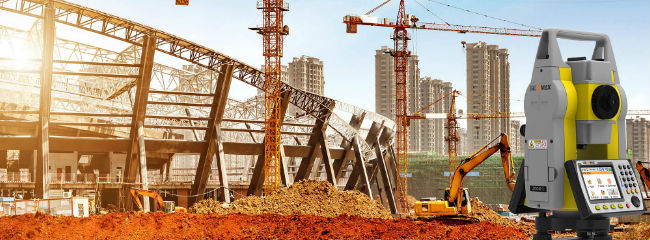Important Operations of Total Station in Soudi Arabia

Distance Measurement:
Electronic distance measuring (EDM) instrument is a major part of total station. Its range varies from 2.8 km to 4.2 km. The accuracy of measurement varies from 5 mm to 10 mm per km measurement. They are used with automatic target recognizer. The distance measured is always sloping distance from instrument to the object. Angle Measurements: The electronic theodolite part of total station is used for measuring vertical and horizontal angle. For measurement of horizontal angles any convenient direction may be taken as reference direction. For vertical angle measurement vertical upward (zenith) direction is taken as reference direction. The accuracy of angle measurement varies from 2 to 6 seconds.
Data Processing
This instrument is provided with an inbuilt microprocessor. The microprocessor averages multiple observations. With the help of slope distance and vertical and horizontal angles measured, when height of axis of instrument and targets are supplied, the microprocessor computes the horizontal distance and X, Y, Z coordinates. The processor is capable of applying temperature and pressure corrections to the measurements, if atmospheric temperature and pressures are supplied.
Display
Electronic display unit is capable of displaying various values when respective keys are pressed. The system is capable of displaying horizontal distance, vertical distance, horizontal and vertical angles, difference in elevations of two observed points and all the three coordinates of the observed points.
Electronic Book:
Each point data can be stored in an electronic note book (like compact disc). The capacity of electronic note book varies from 2000 points to 4000 points data. Surveyor can unload the data stored in note book to computer and reuse the note book.
Use of Total Station
The total station instrument is mounted on a tripod and is levelled by operating levelling screws. Within a small range instrument is capable
of adjusting itself to the level position. Then vertical and horizontal reference directions are indexed using onboard keys. It is possible
to set required units for distance, temperature and pressure (FPS or SI). Surveyor can select measurement mode like fine, coarse, single or
repeated.
When target is sighted, horizontal and vertical angles as well as sloping distances are measured and by pressing appropriate keys they are
recorded along with point number. Heights of instrument and targets can be keyed in after measuring them with tapes. Then processor computes
various information about the point and displays on screen.
This information is also stored in the electronic notebook. At the end of the day or whenever electronic note book is full, the information
stored is downloaded to computers.
The point data downloaded to the computer can be used for further processing. There are software like auto civil and auto plotter clubbed
with AutoCad which can be used for plotting contours at any specified interval and for plotting cross-section along any specified line.
Advantages of Using Total Stations
The following are some of the major advantages of using total station over the conventional surveying instruments:
Field work is carried out very fast.
Accuracy of measurement is high.
Manual errors involved in reading and recording are eliminated.
Calculation of coordinates is very fast and accurate. Even corrections for temperature and pressure are automatically made.
Computers can be employed for map making and plotting contour and cross-sections. Contour intervals and scales can be changed in n time.
However, surveyor should check the working condition of the instruments before using. For this standard points may be located near
survey offic and before taking out instrument for field work, its working is checked by observing those standard points from the
specified instrument station.
